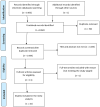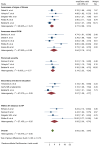Utilization of integrated community-based case management of childhood illness and associated factors in Ethiopia: a systematic review and meta-analysis
- PMID: 39080691
- PMCID: PMC11389298
- DOI: 10.1186/s13052-024-01702-0
Utilization of integrated community-based case management of childhood illness and associated factors in Ethiopia: a systematic review and meta-analysis
Abstract
Background: Despite significant progress being made in reducing under-five mortality, three-fourths of under-five deaths are still caused by preventable conditions such as pneumonia, diarrhea, malaria, and newborn issues. Integrated community case management of childhood illnesses (ICCM) could serve as a means to reduce preventable child mortality in Low- and Middle-Income countries. Our aim was to assess the overall level of ICCM utilization and its associated factors in Ethiopia.
Methods: Candidate studies for inclusion in this review were identified through searches across various databases, including PubMed, EMBASE, Google Scholar, and university repositories online databases, spanning from February 1, 2024, to March 18, 2024. The quality assessment of the studies included in this systematic review and meta-analysis was conducted using the Newcastle-Ottawa Quality Assessment Scale (NOS). Data extraction and analysis were carried out using Microsoft Excel and Stata 17 software, respectively. Heterogeneity among the studies was assessed using Cochran's Q test and I2 statistics, while the presence of publication bias was evaluated through funnel plots and Egger's regression asymmetry test. Subgroup analysis was performed based on sample size and study site.
Results: In this study, the pooled level of ICCM utilization was found to be 42.73 (95%, CI 27.65%, 57.80%) based on the evidence obtained from ten primary studies. In this review, parents' awareness about illness (OR = 2.77, 95%, CI 2.06, 3.74), awareness about ICCM service (OR = 3.64, 95%, CI 2.16, 6.14), perceived severity of the disease (OR = 3.14, 95%, CI 2.33, 4.23), secondary/above level of education (OR = 2.57, 95%, CI 1.39, 4.77), and live within 30 min distance to the health post (OR = 3.93, 95%, CI 2.30, 6.74) were variables significantly associated with utilization of ICCM in Ethiopia.
Conclusion: The utilization of ICCM was found to be low in Ethiopia. Factors such as parents' awareness about the illness, knowledge of ICCM services, perceived severity of the disease, attending a secondary or more level of education, and living within 30 min distance to the health post were significantly associated with the utilization of ICCM. Therefore, it is crucial to focus on creating awareness and improving access to high-quality ICCM services to reduce child morbidity and mortality from preventable causes.
Keywords: Associated factors; Child mortality; Ethiopia; ICCM; Utilization.
© 2024. The Author(s).
Conflict of interest statement
There is no competing interest among the authors in this study.
Figures







Similar articles
-
Integrated community case management of childhood illness in low- and middle-income countries.Cochrane Database Syst Rev. 2021 Feb 10;2(2):CD012882. doi: 10.1002/14651858.CD012882.pub2. Cochrane Database Syst Rev. 2021. PMID: 33565123 Free PMC article.
-
Access to integrated community case management of childhood illnesses services in rural Ethiopia: a qualitative study of the perspectives and experiences of caregivers.Health Policy Plan. 2016 Jun;31(5):656-66. doi: 10.1093/heapol/czv115. Epub 2015 Nov 24. Health Policy Plan. 2016. PMID: 26608585 Free PMC article.
-
Quality and use of IMNCI services at health center under-five clinics after introduction of integrated community-based case management (ICCM) in three regions of Ethiopia.Ethiop Med J. 2014 Oct;52 Suppl 3:91-8. Ethiop Med J. 2014. PMID: 25845078
-
Determinants of Utilization of Health Extension Workers in the Context of Scale-Up of Integrated Community Case Management of Childhood Illnesses in Ethiopia.Am J Trop Med Hyg. 2015 Sep;93(3):636-647. doi: 10.4269/ajtmh.14-0660. Epub 2015 Jul 20. Am J Trop Med Hyg. 2015. PMID: 26195461 Free PMC article.
-
Parent-adolescent communication on sexual and reproductive health issues and its associated factors in Ethiopia: a systematic review and meta-analysis.Ital J Pediatr. 2020 Oct 30;46(1):162. doi: 10.1186/s13052-020-00921-5. Ital J Pediatr. 2020. PMID: 33126919 Free PMC article.
References
-
- UNICEF-WHO. Overview and Latest Update on Integrated Community Case Management: Potential for Benefit to Malaria Programs 2015.
-
- Nations U. TRANSFORMING OUR WORLD: THE 2030 AGENDA FOR SUSTAINABLE DEVELOPMENT 2015.
-
- Levels. & Trends in Estimates developed by the UN Inter-agency Group for Child Mortality Estimation Child Mortality. 2018.
Publication types
MeSH terms
LinkOut - more resources
Full Text Sources

